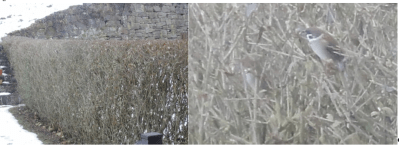Hedges aren’t just a pretty garden decoration. They’re also a major habitat for many species of insects, birds, and other wildlife. In some areas, a lot of hedge trimming goes during the time that local birds are raising their fledglings, which causes harm at a crucial time. Thus, [Johann Elias Stoetzer] and fellow students were inspired to create Hedge Watcher.

The concept is simple – using thermal vision to spot birds inside a hedge when they may not otherwise be easily visible. Many species blend in with their surroundings in a visual manner, so thermal imaging is a great way to get around this. It can help to avoid destroying nests or otherwise harming birds when trimming back hedges. The idea was sourced from large-scale agricultural operations, which regularly use thermal cameras mounted on drones to look for wildlife before harvesting a field.
However, staring at a thermal camera readout every few seconds while trimming hedges isn’t exactly practical. Instead, the students created an augmented reality (AR) monocular to allow the user to trim hedges at the same time as keeping an eye on the thermal camera feed. Further work involved testing a binocular AR headset, as well as a VR headset. The AR setups proved most useful as they allowed for better situational awareness while working.
It’s a creative solution to protecting the local birdlife, and is to be applauded. There’s plenty of hubris around potential uses for augmented reality, but this is a great example of a real and practical one. And, if you’re keen to experiment with AR yourself, note that it doesn’t have to break the bank either!


















Birds aren’t real.
The entire cat population says otherwise, tasty feathered meals are the real deal.
https://birdsarentreal.com/
Speaking of which, as I love birds and their many songs as much as I love my gorgeous black short hair cat, she’s never outside without me walking her on a lead. Sadly, most cat people don’t do this.
I was disappointed to learn that thermal cameras don’t actually work that well to detect wildlife. Most animals have fur or in this case feathers that are designed to insulate so the surface temperature is pretty close to ambient. Likewise feet (or paws, noses, or other exposed areas) do not have a lot of blood flow for the same reason. Not to say they’re invisible on a thermal image but humans are exceptionally “leaky” animals as far as thermal radiation goes so you can’t expect the same results.
Mother nature is no fool, predators evolve to hunt at night, and prey evolves to avoid getting hunted at night. Humans are at the top of the food chain, not worried about getting hunted, so they lost most of their fur, and they tend to shave off most of the rest ( as a symbol of defiance, ask any goth why they do it ).
Snakes with infrared pit organs seem to do a good job of catching our furry or feathered friends.
I remember reading about scientists using thermal cameras while overflying the Arctic. This was supposed to gather the animal heat signatures so they could count the polar bears. They found the polar bears’ fur was so efficient they didn’t show up on camera (as you stated).
It blew my mind when I read that. Neat!
In the 1990s I spent some time in European nature. With military grade thermal imaging equipment there is not a living mammal or bird that you cannot see from several hundred meters away. As far as image resolution gets you. Temperature resolution was less than 1 K.
But this was with sensors cooled to very low temperatures, not that fancy Ardiuno shields of today.
“Thermal Cameras” have a wide range of quality. With a standard type you may not get good results in this use case.
40 years ago I saw a public service announcement on TV sending this message that some hedges and borders should be left alone. 10% to 15 % of your land big or small should be left alone for this reason. Year round. Unfortunately Honeysuckle Bush has invaded which is taking over these former habitats.
“In some areas, a lot of hedge trimming goes during the time that local birds are raising their fledglings”. So maybe you could trim the hedge at a different time?
Well, there is actually a law against it (in Germany)… but especially companies taking care of gardening see themselves in a situation where house owners expect them to “work for their money” while they actually should not do cutting work.
This is a way to “play” with technology to at least take some responsibility…